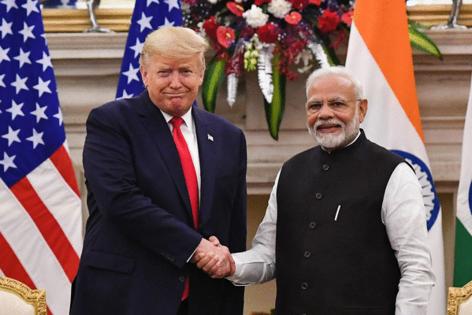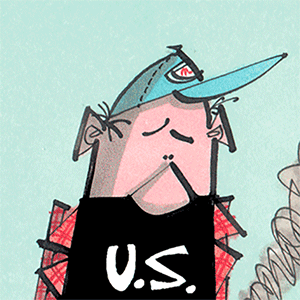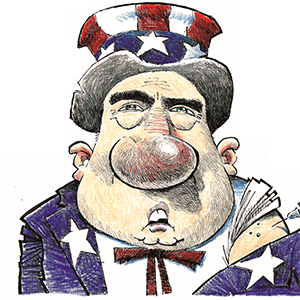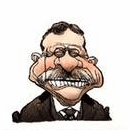India aghast at Donald Trump's 'dead' economy jibe, 25% tariffs
Published in News & Features
Shock, dismay and angst swept across India as businesses, policymakers and citizens digested U.S. President Donald Trump’s sharp remarks and a surprise 25% tariff rate earlier this week.
While Indian government officials weighed a response and business groups tallied the cost of the trade barrier, the local social media flared up with users protesting Trump’s comments and criticizing Indian Prime Minister Narendra Modi for not speaking up.
It started with Trump saying that India’s trade barriers were the “most strenuous and obnoxious,” in a Truth Social post July 30. He added the U.S. may also impose a penalty for New Delhi’s purchase of Russian weapons and energy. Less than a day later, he ripped into India again for aligning with Russia, calling them “dead economies” in another post.
With no imminent trade deal, the 25% tariffs kicked in as of Friday. India is hardly alone in facing Trump’s trade wrath — and not the subject to the very highest rates — but the news left business and political leaders wondering how to cope with the fallout.
“Overnight, the U.S.-India trade equation shifted from tense to turbulent,” said Akshat Garg, assistant vice president at Choice Wealth, a Mumbai based financial services company. The levies “feel less like structured policy and more like a blunt-force political message.”
Complicating the narrative around the India trade deal — or the lack of it — was the U.S. pact with its traditional rival Pakistan that came through on the same day.
As the U.S. released rates across the world on Aug. 1, India’s relative disadvantage to competitor exporting countries became more apparent, dampening moods and stoking tempers further.
“The biggest blow is that Pakistan and Bangladesh got a better rate than us,” V. Elangovan, managing director at SNQS Internationals, an apparel maker in the south Indian manufacturing hub of Tirupur, told Bloomberg News. “We were expecting something in the 15 to 20% range.”
India’s annoyance can be traced back in part to Trump declaring himself the peacemaker that helped broker a ceasefire in the armed conflict between India and Pakistan in May. The move was seen as an effort to upstage Modi and put the two South Asian neighbors on an equal footing, despite India’s larger military and economy.
The events of this week have cemented that impression further in the eyes of some Indian observers.
When the tariff rate news first dropped in late Wednesday evening in India, Ashish Kanodia recalls being “very disturbed.” A director at Kanodia Global, a closely held exporter that gets over 40% of its revenue from the U.S. selling home fabrics to toys, the entrepreneur already has two of its largest U.S. customers seeking discounts to make up for the levy.
“The next six months are going to be difficult for everyone,” Kanodia said, adding that profit margins will be squeezed. If the pain continues for “months and months,” he said he’ll have to start cutting his workforce.
The U.S. is India’s largest trading partner, with the two-way trade between them at an estimated $129.2 billion in 2024.
Compared with India’s 25%, Bangladesh was subjected to a 20% tariff, Vietnam got a 20% levy and Indonesia and Pakistan each received 19% duties.
“We know that we have got a deal that is worse than other countries,” said Sabyasachi Ray, executive director at The Gem and Jewelry Export Promotion Council. “We will take it up with the government.”
Trump’s actions mark a 180-degree turn for New Delhi’s hopes of preferential treatment over regional peers. It was among the first to engage Washington in trade talks in February, confident of hammering out a deal sooner than others.
Trump had called Modi “my friend” in a Feb. 14 post on X and the bond between the two countries “special.”
India is now weighing options to placate the White House, including boosting U.S. imports, Bloomberg News reported citing people familiar with the matter, and many hope that the bilateral relationship and the tariff rate can still be improved.
“It is a storm in the India-U.S. relationship at this moment but I think there’s a good chance that it will go away,” Vivek Mishra, deputy director of the Strategic Studies Programme at Delhi based Observer Researcher Foundation, told Bloomberg News.
Indian business and trade groups are supporting the government’s stance on the deal as the negotiations for a U.S.-India trade deal continue.
Jewelry businesses “are worried but they are not panicking” because they hope a more favorable deal can be worked out, said Ray of the gems export body. “The negotiation that should be happening should be a win-win, not a win-lose.”
The abrupt announcement by Trump over social media when negotiations with India were ongoing “seems like a knee-jerk reaction,” according to Rohit Kumar, founding partner at public policy research company The Quantum Hub.
“This appears to be a negotiating tactic aimed at unresolved discussion points,” Kumar said.
©2025 Bloomberg L.P. Visit bloomberg.com. Distributed by Tribune Content Agency, LLC.







Comments